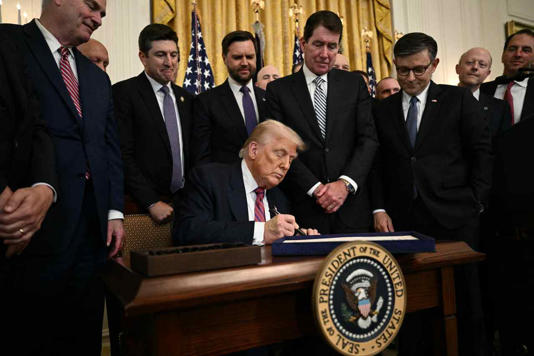
President Donald Trump signed the Guiding and Establishing National Innovation for U.S. Stablecoins Act into law on July 18.© BRENDAN SMIALOWSKI/AFP via Getty Images
About the author: Mark Copelovitch is a professor of political science and public affairs and director of the Center for European Studies at the University of Wisconsin-Madison. He is the co-author of Banks on the Bank: Global Capital, Securities Markets, and the Political Roots of Financial Crises and author of The International Monetary Fund in the Global Economy: Banks, Bonds, and Bailouts.
Last week, the president signed into law the Genius Act, which sets ground rules for stablecoins, pegging the cryptocurrency one-to-one to the U.S. dollar and requiring them to be backed by safe assets such as U.S. Treasuries. Proponents of the law embrace stablecoins as a safe alternative to government fiat—a new, modern form of money.
But I am concerned that this legislation, and the broad adoption of stablecoins that it will facilitate, may trigger a crisis at the very heart of the banking system.
As the Bank for International Settlements recently noted, stablecoins violate the “singleness of money.” Since a stablecoin could trade at varying exchange rates to par against the dollar, an asset supposedly worth a dollar might not always be worth a dollar. Barry Eichengreen, a leading expert on the history of the international monetary system, and others, have warned that this could create problems that mirror those of the 19th century American era of “wildcat” free banking and financial panics. Eichengreen predicts a similar era of crises and instability in the years ahead.
I share his concerns. I am deeply skeptical about stablecoins’ effects on financial stability, as well as their viability as an alternative to fiat currencies. But my anxieties run deeper than worries about new non-bank institutions issuing unstable “stablecoins” and reviving the financial problems of antebellum America.
I am a scholar of the international political economy and the politics of financial crises. In 2020, I co-authored a book with MIT professor David Singer about why some countries are more prone to systemic banking crises than others. Our research highlighted the effects of two variables in combination: foreign capital inflows and financial market structure. We found that foreign capital fuels banks’ dangerous behavior, whereas banks are more likely to take on excessive risks when operating in a financial system with large securities markets. I see parallels here to stablecoins.
The Genius Act will likely trigger a new wave of foreign capital inflows. Since stablecoins will need to be backed by Treasuries or equivalent low-risk assets, they will attract international investors in search of “safe” assets. Stablecoins may not turn out to be truly safe. But, in the short term, their emergence as a new dollar-backed asset is highly likely to spark more capital flows into the U.S. financial system. This is precisely the fuel that makes banking crises more probable.
The growth of stablecoins will also substantially increase all major commercial banks’ exposure to the entire crypto sector, and whether or not one believes that stablecoins are more stable than “regular” crypto products, the entire sector is rife with volatility, speculation, and illicit activity. Even if banks don’t engage directly in illegal crypto activity or in direct speculative investment in crypto, their increased exposure to stablecoins—via investment of profits in the markets or loans to clients heavily exposed to crypto—will unavoidably raise their risk levels.
The Genius Act also indirectly incentivizes banks to engage in more risky “plain vanilla” commercial lending. We are very likely to see capital flight from bank deposits to stablecoins, as the latter increase in volume and prominence. Indeed, the Treasury Department has projected that as much as $6.6 trillion in commercial bank deposits may be at risk of migrating to stablecoins in the years ahead. If this happens, banks may be forced to raise interest rates to retain deposits or to lower their lending standards in search of greater profits.
Again, these incentives, driven by worries about losing customers and income on the deposit side, will exist regardless of whether or not a bank is directly involved in issuing or trading stablecoins. Either way, the baseline risk of a systemic banking crisis in the U.S. increases.
At the same time, the Genius Act will, paradoxically, reinforce the dollar’s dominance in global finance. Since President Donald Trump’s re-election, the dollar has depreciated significantly. Many are predicting the end of dollar hegemony. To be sure, the U.S. faces serious problems of democratic backsliding. Trump’s trade and economic policies have sown major uncertainty about its future economic and geopolitical leadership.
But the math is simple: If stablecoins must be backed by dollar-denominated assets, and they grow exponentially in the years ahead, then demand for the dollar will also massively increase.
Stablecoin operators are now predicted to hold more short-term U.S. debt than China, Japan, or the U.K. If things develop as envisioned by the designers of the Genius Act, that trend will accelerate in the years ahead. Rather than undermining fiat currencies and reducing dollar dominance, growth in U.S. stablecoins will have precisely the opposite effect. This will happen despite the rising concerns of foreign governments and investors about the Trump administration’s increasingly aggressive weaponization of the dollar—through sanctions, tariffs, and other policies.
In a perverse way, stablecoins will also reinforce dollar dominance over the longer term not because of positive developments but because of the increased probability of a major financial crisis.
No other country can act as an international lender of last resort like the Federal Reserve. Neither the European Central Bank, nor the Bank of Japan, nor the People’s Bank of China have swap lines on remotely the scale of the Federal Reserve. The idea that any of these central banks could backstop the world economy through open market operations and the provision of large-scale liquidity, as the U.S. and the Fed have done twice in the last two decades, is highly implausible.
So imagine there is a bank run on stablecoins. Investors start dumping the trillions in Treasuries and money market funds they hold to back their stablecoins. This panic-selling would trigger bond price collapses and lead to spikes in interest rates and broader financial stability. Invariably, the Fed would intervene. The result, as in the wake of both the 2008-09 financial crisis and the Covid-19 crisis, will be an increase in dollar dominance, rather than a decline.
Stablecoins and the Genius Act feel revolutionary to some. But we have been here before—both with global capital inflows and government policies jointly creating the preconditions for future financial crises and those crises increasing, rather than decreasing, the dominance of the dollar in global finance. In fact, this is very much the story of the post-Bretton Woods international monetary system, ever since President Richard Nixon closed the gold window in 1971.
The future of stablecoins and systemic banking and financial crises is not guaranteed. But last week, the probability of a major crisis significantly increased—even as the centrality of the dollar in the global economy in the next decades also became more certain than ever.
Guest commentaries like this one are written by authors outside the Barron’s newsroom. They reflect the perspective and opinions of the authors. Submit feedback and commentary pitches to [email protected].
Story by: Mark Copelovitch



